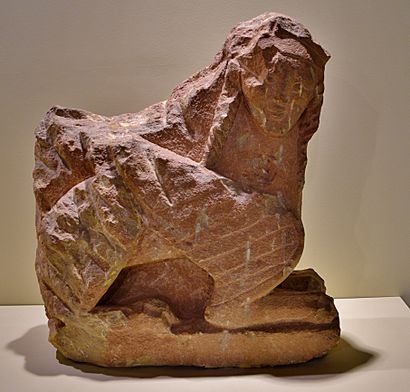Sphinx of Haches facts for kids
Quick facts for kids Sphinx of Haches |
|
|---|---|
| Spanish: Esfinge de Haches | |
 |
|
| Year | circa 5th century BC |
| Medium | Sandstone |
| Dimensions | (65 x 60 x 25) cm |
| Location | Albacete Provincial Museum, Albacete, Spain |
The Sphinx of Haches is an ancient statue from the Iberian Peninsula. It shows a mythical creature called a sphinx, which has the body of a lion and the head of a human. You can see this amazing sculpture at the Albacete Provincial Museum in Spain.
This sphinx was made around the 5th century BC, which is over 2,500 years ago! It's a great example of the art created by the Iberians, an ancient people who lived in what is now Spain and Portugal.
What is a Sphinx?
A sphinx is a legendary creature found in the myths of many cultures. It often has the body of a lion and the head of a human. Sometimes, it might also have the wings of a bird.
In ancient Egypt, sphinxes were seen as guardians. They often protected temples and tombs. The most famous one is the Great Sphinx of Giza.
In ancient Greece, the sphinx was often shown as a dangerous creature. It would ask riddles and harm those who could not answer them. The Sphinx of Haches is an Iberian version, showing influences from Greek art.
A Link to Ancient Greece
The Sphinx of Haches shows how much the ancient Greeks influenced the Iberian people. Greek settlers came to the Iberian Peninsula (where Spain is today) from the 5th century BC onwards. They brought their ideas about art and culture.
You can see this influence in the sphinx's smile. It looks a lot like the smiles on statues called korai. These were statues of young women made in ancient Greece during a time called the Archaic period. This period was from about 800 BC to 480 BC.
How It Was Found
The Sphinx of Haches was discovered in 1947. Workers found it while doing farm work in a place called Cerro de los Gavilanes. This area is near the tower of Haches, in the town of Bogarra, Spain.
Finding such an old and detailed sculpture helps us learn more about the ancient Iberian people. It also shows how different cultures shared ideas and art styles long ago.
See also
 In Spanish: Esfinge de Haches para niños
In Spanish: Esfinge de Haches para niños

